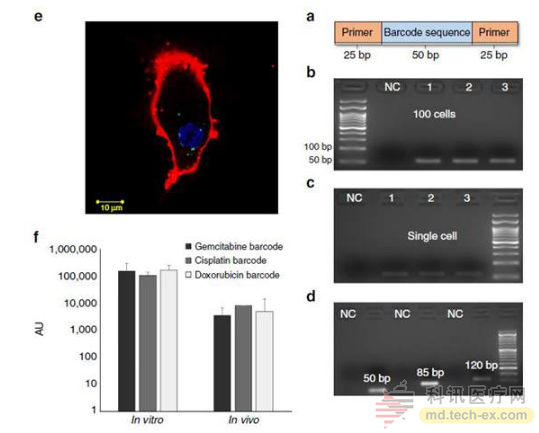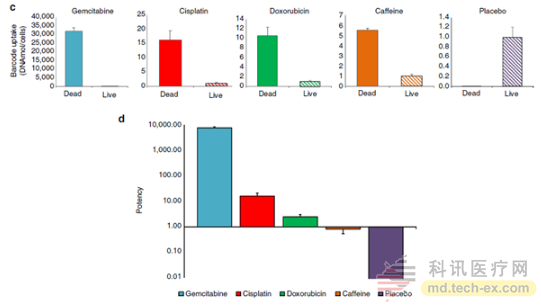DNA barcodes, private custom nano drugs!
Release date: 2017-03-20
Imagine a patient going to the hospital one day in the future. After the diagnosis, the doctor will give him/her a small dose of a mixture containing hundreds of nanomedicines in order to determine the nanomedicine suitable for him/her. The next day from the lesion The area is taken out of the tissue for testing, and then the most suitable nanomedicine is determined and treated... It sounds like a bit of a fantasy, but the researchers’ latest research is moving toward such personalized treatment goals, they use a The technology of DNA barcodes is used to screen nanomedicines in order to achieve personalized treatment. So what is a DNA barcode? In fact, a DNA barcode is a sequence of nucleotides that can be decoded by PCR amplification and gene sequencing. By labeling nanomedicine with DNA barcodes, researchers can identify the best therapeutics and determine the distribution of different nanoparticles.
At the end of 2016, a team of professors from the Israel Institute of Technology, Professor Avi Schroeder, published a research paper on personalized treatment of anti-tumor nanomedicines at Nature Communications. They used DNA barcode technology to bind liposomes containing different anticancer drugs. The anticancer efficacy of nanomedicine was predicted and validated [1].
At present, the screening of anticancer drugs for clinical use is mainly carried out by in vitro culture or transplantation into immunodeficient mice, and then testing for drug sensitivity, but due to the complexity of the tumor environment, this method is time consuming and complicated to operate. The accuracy rate is not high. In order to solve these problems, Schroeder et al. proposed the use of DNA barcode technology to label, track and evaluate the effects of nano-anticancer drugs at the single cell level.

Figure 1. Flow chart of DNA barcode technology for predicting the anticancer effects of different nanomedicines. Image source: Nat. Commun.
Because liposome nano drugs have been used clinically, they can be effectively enriched in tumor tissues to improve the anticancer effect of drugs. The researchers used liposomes to load different anticancer drugs and corresponding DNA barcodes (50-120 base pair DNA). Sequence), forming a variety of 100 nm nanoparticles. They selected three clinically used drugs for the treatment of triple-negative breast cancer (TNBC) (doxorubicin, cisplatin, gemcitabine) in mice, one drug corresponding to a barcode to form a nanoparticle. Through in vitro cellular uptake experiments, they found that this DNA barcode can be detected and quantified at the single cell level (Figure 2).

Figure 2. DNA barcodes can be detected at the single cell level. Image source: Nat. Commun.
Subsequently, in order to test whether the barcode nanoparticles can predict the anticancer effect of anticancer drugs, they will be divided into three kinds of liposomes containing different drugs and two control liposomes (one containing caffeine, one not including The compounds were mixed together and injected into the TNBC-producing mice at a dose less than 1 / 1000 of the clinical dose. After 48 hours, part of the tumor tissue was taken and digested into a single cell suspension, which was killed by flow cytometry. The cells and living cells are separately collected and made into cell lysates, and the DNA barcodes are extracted for amplification and quantitative detection.
In order to define the anticancer effect of drugs, they define drugs with high levels of dead cells as drugs with good efficacy. Drugs with high levels of living cells are defined as drugs with poor efficacy, with a certain amount of DNA in dead cells. The DNA barcode content in the cell defines the sensitivity of the cell to the drug. A higher ratio indicates that the cell is more sensitive to the drug, ie, the drug is more effective. It was found that the DNA barcode corresponding to gemcitabine was much higher in dead cells than in living cells, which means that gemcitabine has the best anticancer effect (Fig. 3). So is this actually the case?

Figure 3. Using barcode nanoparticles to predict the anticancer efficacy of multiple drugs. Image source: Nat. Commun.
In order to verify the accuracy of the prediction results of barcode nanoparticles, they carried out mouse treatment experiments. The results are shown in Figure 4. The therapeutic effect of gemcitabine is the best: the tumor volume and mass are the smallest, and the number of apoptosis in the tumor is also the highest. This indicates that DNA barcode nanoparticle is an effective diagnostic technique for rapidly predicting the anticancer effect of anticancer drugs. The detection time is short, the operation is simple, and the accuracy is high.

Figure 4. The anticancer effects of different nanomedicines are highly consistent with the predicted results. Image source: Nat. Commun.
Professor Schroeder believes that this new technology not only helps to screen for the best anticancer drugs, but also provides a new way to study the resistance of tumors to different drugs. At the same time, he also said: "My thoughts are more practical: How can our research help patients? The current research results make me very excited, but we still need to do more work to develop our technology into a product that the public can easily obtain. But I believe that this technology will definitely enter the clinic in the near future."
However, for nanomedicine, in vivo screening of drugs is important, but in vivo screening of nanoparticle properties may be more important, because the nature of nanoparticles determines the amount of nanomedicine enriched in various tissues and organs, which is also It directly determines the efficacy and side effects of the drug. At the same time, the in vivo screening of nanoparticle properties is more cumbersome, because the composition of nanoparticles is not only related to the types of constituent molecules, but also the molecular weight of the corresponding molecules, the proportion of hydrophilic and hydrophobic segments, the proportion of different components, etc. Do your best! Therefore, it is time-consuming and labor-intensive to use the in vivo screening.
To this end, researchers from the University of Florida, Georgia Institute of Technology, and the Massachusetts Institute of Technology have successfully solved the problem of nanoparticle in vivo screening using similar principles and methods, enabling rapid high-throughput screening. Their experimental results show that DNA barcode technology can simultaneously screen 30 kinds of nanoparticles in a mouse, and quickly and accurately compare the enrichment of different nanoparticles in different organs at different times, and the experimental results are reproducible. Greatly saved the resources needed for screening (especially experimental animal resources), and the relevant research results were published on PNAS in February this year. The authors include the well-known professor Robert Langer [2].

Figure 5. Schematic diagram of high-throughput screening of nanoparticles using DNA barcodes. Image source: PNAS
There is no doubt that DNA barcode technology will bring great progress to the development of nanomedicine, which brings hope for rapid and accurate screening of drugs and nanoparticles, allowing researchers to simultaneously carry out more than 1 / 1000 of clinical doses. In vivo quantitative studies of drugs and various properties of nanoparticles. If combined with microfluidic nanoparticle preparation technology, nanoparticle from preparation to screening will no longer be a problem, which will inevitably accelerate the development and optimization of nanomedicine and promote the clinical transformation of nanomedicine.
references:
1. Yaari Z, Da Silva D, Zinger A, et al. Theranostic barcoded nanoparticles for personalized cancer medicine. Nat. Commun., 2016, 7, 13325, DOI: 10.1038/ncomms13325
2. Dahlman JE, Kauffman KJ, Xing Y, et al. Barcoded nanoparticles for high throughput in vivo discovery of targeted therapeutics. PNAS, 2017, 114, 2060-2065, DOI: 10.1073/pnas.1620874114
Source: X-MOL
4D Cog 21G60mm,Pdo Thread Korea,Fio De Pdo,Minerva Premium Pdo Thread Lifting
Qingdao Beautiful Skin Biotechnology Co., Ltd , https://www.hafilleresthetic.com